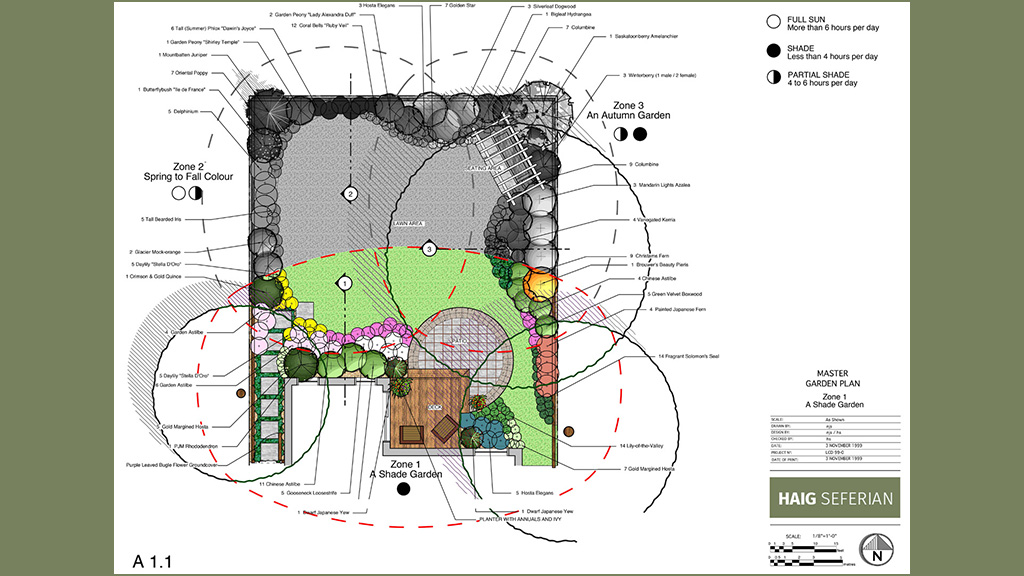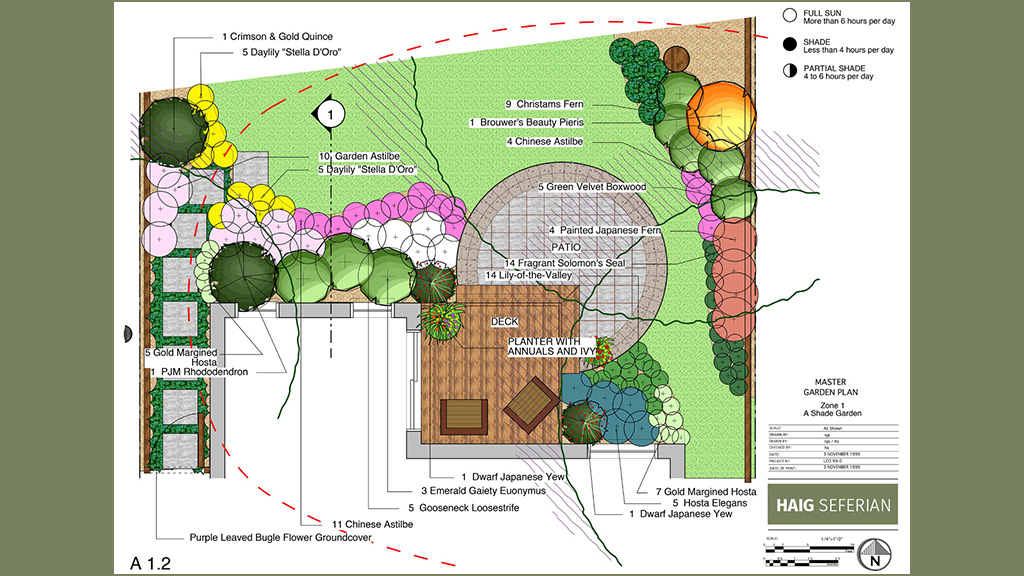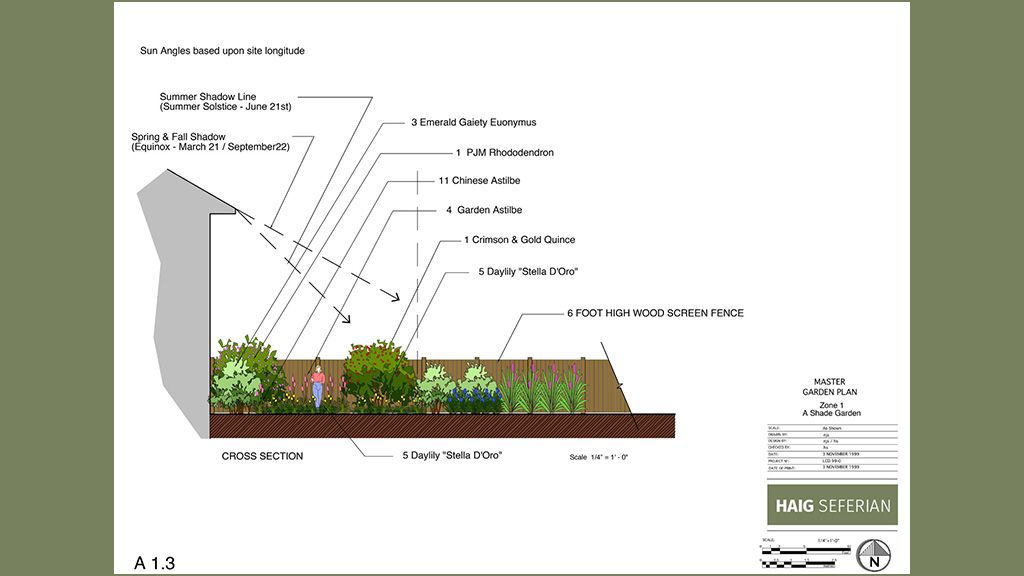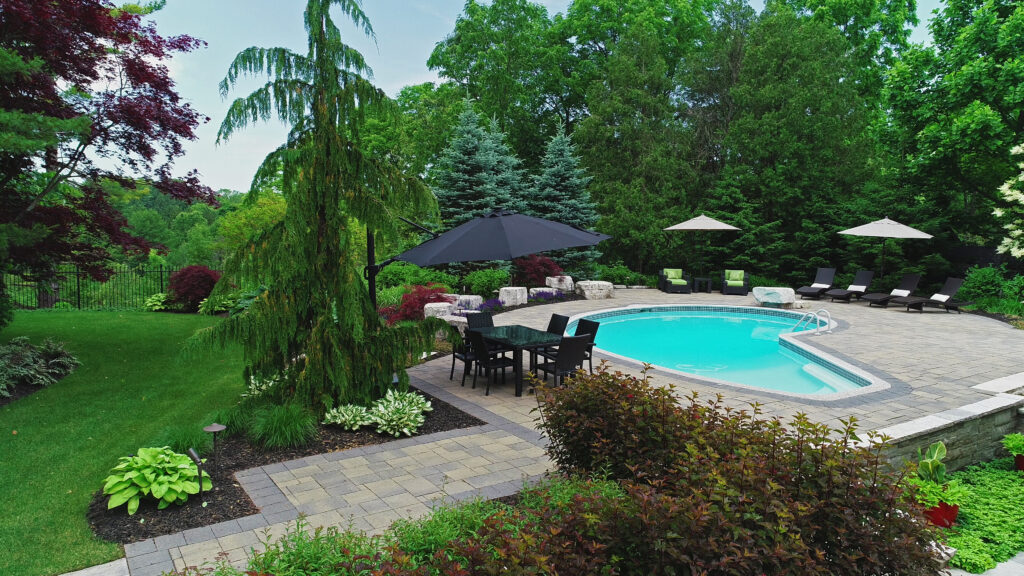Imagine a dry, hot summer day when the one thing you long for is some relief in a tranquil spot in the shade. Or walking down a winding garden path and spotting a small lush area of greenery housing an intimate dimly lit bench. You sense a touch of mystery in the middle of the day as you proceed to linger in the shady nook and take a deep breath of fresh air.
As much as we long for sunny days, shade provides us with meditational respite. A garden in the shade heightens and soothes our senses in a way that other types of gardening are unable to do. A shade garden calms us with its serene beauty, subtle colours and interesting shapes. Instead of bright, bold colours, shade plants offer us soft pastels and iridescent whites. In addition, shade gardens are also easier to maintain than gardens requiring significantly more sunshine and have fewer weeds and pests.

Before you can begin designing your shade garden, you must first decide what type of shade you have by keeping track of where the sun is and what sort of shade it creates for different times of day. There are different types of shade that are essentially categorized as open shade, thin shade, medium shade, full shade and dense (heavy) shade. Open shade is the lightest shade, on a scale of light to dark, and is the easiest to work with. An open shade area is one that receives about 3-6 hours of sunlight in a day.

Thin Shade is next in intensity and is usually found under branches of trees. This type of garden should receive an hour or two of full, unobstructed light every day.
Next comes medium shade, which is an area with reflected sunlight. This area should be in the shade for approximately 4 hours of the day.
Full shade is generally found under the leaves of mature plants, which allows very little sunlight to filter through the leaves. Finally, there is dense (heavy) shade found under mature evergreens or between buildings. Areas such as this tend to be dark, cold and dry and not conducive to permanent gardening.
Once you have decided what type of shade your area experiences you can stay out to find the right plants that will flourish there. You must bear in mind that shade changes as the seasons do and as your garden matures. Therefore, be prepared to move plants around and have some fun with your garden.
There are a myriad of shade loving plants that can produce a lush garden. Some plants that are ideal for medium shade areas are rhododendrons, daylilies, wax begonias, oakleaf hydrangea, wood anemone, fuchsias and impatiens.

Plants best suited for fully shaded areas are ones that you can find in the woods, such as wild ginger, wintergreen, hellebores, trailing arbutus, pachysandra, ferns, hostas and violets.
The beauty of a shade garden is its informality and diversity of plant material. For example, the following are types of foliage with variegated or coloured leaves that prefer some degree of shade.
| Name | Scientific Name | Colour |
| Blue Oat Grass | Helictotrichon | blue-green |
| Bugleweed | Ajuga Reptans | ivory, pink, green |
| Coleus | Coleus Hybrids | red, yellow, green |
| English Ivy | Hedera Helix Glacier | white, silver |
| English Yew | Taxus Baccata | yellow, green |
| Hosta | Hosta Species | green, gold, white |
| Mock Orange | Philadelphus Coronarius | gold in spring |
| Spotted Dead Nettle | Lamium Maculaturn | spotted, silvery |
| Sweet Flag | Acorus Americanus | striped with yellow |
| Vinca | Vinca major ‘Variegata’ | cream edge |
| Winter Creeper | Euonymus Fortunei Var | with white |
| Yew | Taxus Baccata ‘Aurea’ | golden |
Different vines, perennials and bulbs also add variety to a shade garden. The following are a few examples of what works well in a shade garden:
VINES
| Name | Scientific Name |
| Boston Ivy | Parthenocissus Tricuspidata |
| Clematis Species and hybrids | |
| Trumpet Honeysuckle | Lonicera Sempervirens |
| Virginia Creeper | Parthenocissus Quinquefolia |
| Winter Creeper | Eunoymus Fortunei |
PERENNIALS AND BULBS
| Name | Scientific Name |
| Anemone Species | |
| Astilbe Species | |
| Barrenwort | Vancouveria Species |
| Bee-Balm | Monarda Didyma |
| Bleeding Heart | Dicentra Species |
| Calla Lily | Zantedeschia Species |
| Crested Iris | Iris Cristata |
| Daffodil | Narcissus Species and Hybrids |
| Daylily | Hemerocallis Species and Hybrids |
| Ferns | |
| Foamflower | Tiarella Cordifolia |
| Foxglove | Digitalis Species |
| Hosta Species | |
| Jacob’s Ladder | Polemonium Species |
| Lily | Lilium Species |
| Narcissus Species and Hybrids | |
| Phlox Sepcies | |
| Primrose | Primula Species |
| Siberian Iris | Iris Sibirica |
| Stonecrop | Sedum Species |
| Violet | Viola Species |
Other types of planting work very well in shade garden, depending on what your need are you can venture into annuals and biennials and even ground cover. Here are a few examples of these plants for your reference:
ANNUALS AND BIENNIALS
| Name | Scientific Name |
| Balsam | Impatiens Balsamina |
| Black-Eyed Susan Vine | Thumbergia Alata |
| English Daisy | Bellis Perennis |
| Forget-Me-Not | Myosotis Sylvatica |
| Foxglove | Digitalis Species |
| Impatiens Hybrids | |
| Pansy | Viola x Wittrockiana |
| Scarlet Sage | Salvia Splendens |
| Wishbone Flower | Torenia Fournieri |
GROUND COVERS
| Name | Scientific Name |
| Bearberry | Asarum Species |
| Bunchberry | Cornus Canadensis |
| Creeping Phlox | Phlox Stolonifera |
| Lilyturf | Liriope Species |
| Mondo Grass | Ophiopogon Japonicus |
| Periwinkle | Vinca Minor |
| Wintergreen | Gaultheria Procumbens |
One of the greatest areas for experimentation is with colour. You can organize your planting so that you have colour all year round. Here are some examples of plants that you may incorporate in your garden to give you seasonal colour:
PLANTS FOR SPRING COLOUR
Perennials and Bulbs
| Name | Scientific Name | Colour |
| Bluebellis | Endymion Species | blue/pink/white |
| Lily of the Valley | Convollaria Majalis | fragrant white |
| Marsh Marigold | Caltha Palustris | yellow |
| Periwinkle | Vinca Minor | blue to violet |
| Primrose | Primula Species | red/pink/yellow /blue/orange |
| Solomons’ Seal | Polygonatum Species | fragrant white |
| Trillium Species | white/yellow/pink | |
| Violet | Viola Species | white/blue/purple/yellow |
| Wild Geranium | Geranium Maculatum | lilac-pink |
Shrubs and Vines
| Name | Scientific Name | Colour |
| Azalea | Rhododendron Species | red/rose/yellow/white /orange |
| Drooping Leucothoe | Leucothoe Fontanesiana | white |
| Japanese Kerria | Kerria Japonica | yellow |
| Mountain Laurel | Kalmia Latifolia | pink/rose-red/white |
| Rhododendron | Rhododendron Species | red/rose/pink/white |
| Viburnum | Viburnum Species | white |
PLANTS FOR SUMMER COLOUR
Perennials and Bulbs
| Name | Scientific Name | Colour |
| Astilbe | Astilbe Species | red/rose/pink/white |
| Bellflower | Campanula Species | blue/violet |
| Black Snakeroot | Cimicifuga Racemosa | white |
| Daylily | Hemerocallis Species & Hybrids | red/pink/orange/cream /salmon/yellow |
| Goat’s Beard | Aruncus Diocius | white |
| Hosta | Hosta Species & Hybrids | lavender/white flower |
| Japanese Iris | Iris Kaempferit | red-violet/purple/blue-violet |
| Meadow-Rue | Thalictrum Species | lavender/pink/white |
| Purple Coneflower | Echincea Purpurea | pinkish purple |
Annuals and Biennials
| Name | Scientific Name | Colour |
| Cuplflower | Nierembergia Hippomanica | purple/blue/white |
| Fuchsia Hybrids | Fuschia | red/rose/purple/white |
| Impatiens | Impatiens Hybrids | red/rose/pink/orange violet/salmon/white |
| Lobelia | Lobelia Erinus | blue/white |
| Pansy | Viola x Wittrockiana | red/rose/purple/blue orange/yellow/white |
| Scarlet Sage | Salvia Splendens | red/pink/purple/white |
| Sweet Alyssum | Lobularia Maritima | fragrant white/purple |
| Tuberous Begonia | Begonia x Tuberhybrida | red/rose/yellow/white orange/salmon/pink |
Shrubs and Vines
| Name | Scientific Name | Colour |
| Azalea | Rhododendron Species | red/orange/yellow/ pink/white |
| Clematis | Clematis Species/Hybrids | red/rose/yellow/blue purple/violet/white |
| Glossy Abelia | Abelia Grandiflora | white/pink |
| Hydrangea | Hydrangea Species | pink/blue/white |
| SilverLace Vine | Polygonum Aubertii | white |
| Sweet Pepperbush | Clethra Alnifolia | fragrant, white |
PLANTS FOR AUTUMN COLOUR
Perennials and Bulbs
| Name | Scientific Name | Colour |
| Autumn Snowflake | Leucojum Autumnale | white |
| Cyclamen | Cyclamen Species | rose/pink/white |
| Epimedium | Epimedium Species | reddish leaves |
| Goldenrod | Solidago Species | yellow |
| Italian Arum | Arum Italicum ‘Pictum’ | red berries |
| Japanese Anemone | Anemone x Hybrida | rose/pink/white |
| Ornamental Grasses | gold/tan/cream | |
| Plumbago | Ceratostigma Plumbaginoides | blue |
| Toad Lily | Tricyris Hirta | white |
| Wood Aster | Aster Cordifolius | blue |
Shrubs and Vines
| Name | Scientific Name | Colour |
| Bearberry | Arctostaphylos Uva-Ursi | red berries |
| Boston Ivy | Parthenocissus Tricuspidata | red to orange leaves |
| Bunchberry | Cornus Canadensis | red berries |
| Sasanqua Camellia | Camellia Sasanqua | red/rose/pink/white |
| Sweet Autumn Clematis | Clematis Paniculata | white fragrant |
| Virginia Creeper | Parthenocissus Quinquefolia | red leaves |
| Winter Creeper | Eunoymus Fortunei ‘Colorata’ | reddish purple leaves |
| Wintergreen | Gaultheria Procumbens | red berries |
PLANTS FOR WINTER COLOUR
| Name | Scientific Name | Colour |
| Camellia | Camellia Japonica | red/rose/white |
| Climbing Hydrangea | Hydrangea | attractive bark |
| Heritage River Birch | Betula Nigra ‘Heritage’ | attractive bark |
| Hollies | Ilex Species | red berries |
| Pansy | Viola x Wiurockiana | warm climates – red/ rose/orange/purple |
| Winterberry | Ilex Verticillara | redberries |
Finally, to add architectural structure to your shaded area, use plants in layers at differing heights. Here are some examples of plants you can use to achieve a magnificent garden of diversity in appearance:
UPRIGHT SPIKY AND VERTICAL PLANTS
| Name | Scientific Name |
| Astilbe in bloom | |
| Bear’s Breeches in bloom | Acanthus Mollis |
| Black Snakeroot in bloom | Cimicicfua Racemosa |
| Clivia | |
| Daylily | Hemerocallis Species/Hybrid |
| Foxglove in bloom | Digitalis Species |
| Goat’s Beard in bloom | Aruncus Dioicus |
| Irises | |
| Lilies | |
| Ornamental Grasses | |
| Scarlet Sage | Salvia Splendens |
| Summer Hyacinth | Galtonia Candicans |
| Turtlehead | Chelone Species |
BUSHY, BRANCHED
| Name | Scientific Name |
| Balsam | Impatiens Balsamina |
| Baneberry | Actaea Species |
| Bee Balm | Monarda Didyma |
| Calendula | Calendula Officinalis |
| Goldenrod | Solidago Species |
| Hardy Begonia | Begonia Grandis |
| Jacob’s Ladder | Polemonium Caeruleum |
| Monkshood | Aconitum |
| Persian Violet | Exacum Affine |
MOUNDED PLANTS
| Name | Scientific Name |
| Alumroot | Heuchera Species |
| Astilbe | Astilbe Species/Hybrids |
| Anemone | Anemone Species |
| Bear’s Breeches | Acanthus Mollis |
| Bleeding Heart | Dicentra Species |
| Forget-Me-Not | Myosotis Species |
| Hardy Cyclamen | Cyclamen Species |
| Hosta | Hosta Species/Hybrids |
| Impatiens | Impatiens Hybrids |
| Pansy | Viola x Wittrockiana |
| Primrose | Primula Species |
| Wandflower | Galax Urceolata |
LOW AND SPREADING
| Name | Scientific Name |
| Bearberry | Arctostaphylos Uva-Ursi |
| Bugleweed | Ajuga Species |
| Bunchberry | Cornus Canadensis |
| Creeping Phlox | Phlox Stolonifera |
| Ivy | Hedera Species |
| Lily-of-the-Valley | Convallaria Majalis |
| Pachysandra | Pachysandra Species |
| Periwinkle | Vinca Species |
| Sweet Alyssum | Lobularia Maritima |
| Violet | Viola Species |
| Wild Ginger | Asarum Species |
Take advantage of all of these plants and create a lush garden of a wide variety of plants. You will be pleasantly surprised at what you can do with colour and shapes.

